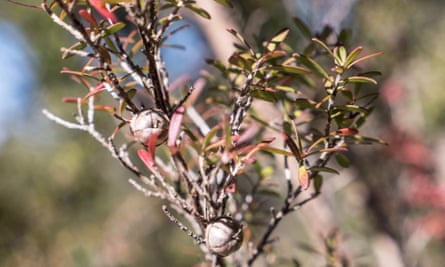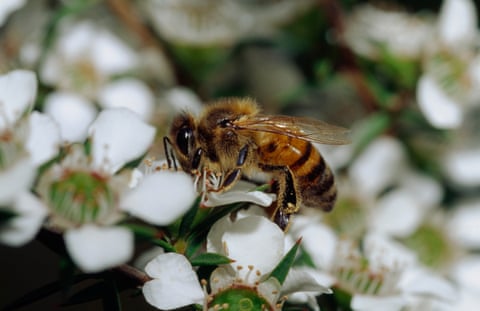Long before the name Mānuka became synonymous with a booming honey industry, celebrity endorsements and protracted global disputes, it was known in Māori legend. After Tāne Mahuta, the god of forests, separated his parents from their locked embrace, he set out to cloak Papatūānuku (his earth mother) in trees. One of these trees, born from his union with Tawake-Toro, was the Mānuka, with its dense, spiky foliage, delicate white flowers and unique pollen.
Mānuka is considered a taonga, or treasure, of which Māori are considered the kaitiaki (guardians). The legend, and the Māori relationship to Mānuka, has become an important tool in a global battle to protect Aotearoa New Zealand’s Mānuka honey brand, the most bitter part of which is between New Zealand and Australia.
The lucrative honey is produced from bees feeding on the pollen of the Leptospermum scoparium plant, native to both Australia and New Zealand, and is famed for its anti-bacterial properties. In New Zealand, it is called Mānuka, in Australia, it is more commonly known as Tea Tree, but the word Manuka (without a macron, which is used to indicate a long vowel) has been in common use in Tasmania for at least 100 years.
Both countries make the honey, both label it Mānuka, or variations thereof, and both have multimillion-dollar export industries relying on that brand.
Some New Zealand batches with a particularly high UMF (unique Mānuka factor) rating fetch NZ$2,000-$5,000 a jar at luxury stores like Harrods in London. Its value and the global demand has led to a spate of crimes in New Zealand, with reports of hive thefts, covert poisonings and fights between beekeepers over land use.

A fight over who can claim the name Mānuka has also now been rumbling for years between Australia and New Zealand, with the latest face-off fast approaching.
New Zealand’s Mānuka Honey Appellation Society first applied to trademark the name in 2015, and the Intellectual Property Office of New Zealand eventually accepted in 2018. But the Australian Manuka Honey Association lodged an objection. A similar sequence of events played out in the UK, after its office accepted a New Zealand trademark application and Australia objected – that hearing is due to be revisited this month.
The hearing in the New Zealand Office was due to take place on 18 August, but was scuppered when the country went into a nationwide lockdown to stamp out a coronavirus outbreak. A decision on a new date is pending.
The Mānuka Charitable Trust – a group representing industry, iwi (tribes) and government – was formed after Australia lodged its objection and will advocate on New Zealand’s behalf, backed by NZ$6m of government funding.
Its chair, Pita Tipene said the goal was simple – to stop the term Mānuka Honey from being used on products made outside New Zealand.
“For Māori, this means that our reo is respected and a precious taonga [treasure] is being honoured and protected. For consumers, it means that they can trust they are getting genuine honey produced in New Zealand from our Mānuka trees. It also protects the industry, export earnings and jobs.”
Tipene likened their plight to that of France battling to stop wine producers labelling their sparkling wines as champagne.
“Now anything labelled champagne must be from that region,” he said. “For us it runs even deeper because Mānuka is our taonga and our reo [language].”
New Zealand was the only country in the world that had a formal, scientific definition for honey derived from Mānuka, which was regulated by the ministry for primary industries, Tipene said.

“This definition requires that all honey exported from New Zealand under the name ‘Mānuka honey’ (which includes variations on the name) meets test requirements, ensuring it is unadulterated and true to labelling. This enables consumer confidence in this genuine and unique honey of New Zealand.”
‘Both countries lose’
John Rawcliffe, the chief executive of the UMF Honey Association, which verifies the authenticity and antimicrobial activity of Mānuka honey, said the trademark was about protecting what was unique to New Zealand.
Rawcliffe pointed out that Australia had 83 varieties of Leptospermum, which the industry there classifies under a broad umbrella as Manuka. But not all of these Leptospermum varieties are created equal.
“It’s like calling all citrus species an orange,” he said.
“If they turn around and say, ‘I’m going to call of these different honeys Manuka because I can quickly make a dollar out of it,’ it is short term, it is incorrect and it is not helping the consumer, nor is it helping Australian beekeepers.
“It is absolutely critical to turn these products into an artisan journey. If we don’t do that, we commodify it and destroy it,” Rawcliffe said. “Both countries lose because we both have a story of our land, of our product and our environment.”

But Australia argues that New Zealand’s attempt to trademark a plant’s name is wrong.
The chair of the Australian Manuka Honey Association (AMHA) , Paul Callander, said the anglicised word ‘Manuka’ had been used in Australia for more than 100 years.
“We will never use the Te Reo Māori version of the word, however, the word Manuka as we spell it has no meaning in the Māori language. We look at that as an Australian word.”
(Rawcliffe challenges this, saying that if anyone were to add a macron on to the word Harrods, or to Penfolds, the name of an Australian wine producer, all hell would break loose.)
Callander said two Māori board members on the AMHA backed Australia’s stance and that there was no “unified Māori approach” on protecting the name.
“This is actually not about benefiting Māori, it is about controlling the industry.”
Callander said it was a false comparison to compare Mānuka to champagne. “Manuka is not a geographical name, it is a plant name, and does not have a right to place-name protection.”
He said the industry was an uneven playing field, with New Zealand dominating the market. Now the New Zealand association had added insult to injury by going after individual Australian beekeepers who were attempting to trademark their own products.
“If you go after bankrupting our beekeepers, we’re going to get pretty upset.”
The AMHA has produced a 5,000-page document for its legal challenge, but Callander said the preference would be for New Zealand and Australia to work together, to share the name, collaborate in the market and set industry standards together.
